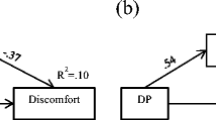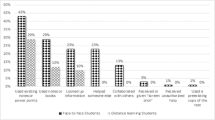Abstract
Using scenario-based survey data from a sample of 330 university students, this study examined the effects of low self-control, rational choice variables, and control measures on intentions to cheat on a college exam. A moderate bivariate association was observed between low self-control and cheating intentions. However, a series of multivariate regression equations showed that low selfcontrol did not have a significant effect on intentions to cheat once the influence of other variables, especially anticipated shame, were controlled. Furthermore, findings supported the rational choice framework in explaining student decisions to cheat. Implications regarding these findings are discussed.
Similar content being viewed by others
References
Akers, R. (1991). Self-control as a general theory of crime.Journal of Quantitative Criminology, 7, 201–211.
Alschuler, A., and Blimling, G. (1995). Curbing epidemic cheating through systemic change.College Teaching, 43, 123–125.
Arneklev, B., Cochran, J., & Gainey, R. (1998). Testing Gottfredson and Hirschi’s low self-control stability hypothesis: An exploratory study.American Journal of Criminal Justice, 23, 107–127.
Arneklev, B., Grasmick, H., Tittle, C., & Bursik, R. (1993). Low self-control and imprudent behavior.Journal of Quantitative Criminology, 9, 225–247.
Bachman, R., Paternoster, R., & Ward, S. (1992). The rationality of sexual offending: Testing a deterrence/rational choice conception of sexual assault.Law and Society Review, 26, 343–372.
Barlow, H. (1991). Explaining crimes and analogous acts, or the unrestrained will grab at pleasure whenever they can.Journal of Criminal Law and Criminology, 82, 229–242.
Benson, M. L., & Moore, E. (1992). Are white-collar and common offenders the same?Journal of Research in Crime and Delinquency, 29, 251–272.
Bishop, D. (1984). Legal and extralegal barriers to delinquency.Criminology, 22, 403–419.
Brownfield, D., & Sorenson, A. (1993). Self-control and juvenile delinquency: Theoretical issues and an empirical assessment of selected elements of a general theory of crime.Deviant Behavior, 4, 243–264.
Bunn, D., Caudill, S., & Gropper, D. (1992). Crime in the classroom: An economic analysis of undergraduate student cheating behavior.Research in Economic Education, 23, 197–207.
Burton, V. S., Cullen, F., Evans, T. D., & Dunaway, R. (1994). Reconsidering strain theory: Operationalization, rival theories, and adult criminality.Journal of Quantitative Criminology, 10, 213–239.
Cornish, D., & Clarke, R. (1986).The reasoning criminal: Rational choice perspectives on offending. New York: Springer-Verlag.
Coston, C. T., & Jenks, D. (1998). Exploring academic dishonesty among under criminal justice majors: A research note.American Journal of Criminal Justice, 22, 235–248.
Davis, S. & Ludvigson, H. (1995). Additional data on academic dishonesty and a proposal for remediation.Teaching of Psychology, 22, 119–121.
Elis, L., & Simpson, S. (1995). Informal sanction threats and corporate crime: Additive versus multiplicative models.Journal of Research in Crime and Delinquency, 32, 399–424.
Eskridge, C., & Ames, G. (1993). Attitudes about cheating and self-reported cheating behaviors of criminal justice majors and non-criminal justice majors: A research note.Journal of Criminal Justice Education, 4, 147–162.
Evans, T. D., Cullen, F., Burton, V., Dunaway, R., & Benson, M. (1997). The social consequences of self-control: Testing the general theory of crime.Criminology, 35, 475–504.
Franklyn-Stokes, A., & Newstead, S. (1995). Undergraduate cheating: Who does what and why?Studies in Higher Education, 20, 159–172.
Genereux, R., & McLeod, B. (1995). Circumstances surrounding cheating: A questionnaire study of college students.Research in Higher Education, 36, 687–704.
Gibbs, J., & Giever, D. (1995). Self-control and its manifestations among university students: An empirical test of Gottfredson and Hirschi’s general theory.Justice Quarterly, 12, 231–255.
Gottfredson, M., & Hirschi, T. (1990).A general theory of crime. Stanford: Stanford University Press.
Grasmick, H., & Bursik, R. (1990). Conscience, significant others, and rational choice: Extending the deterrence model.Law and Society Review, 24, 837–861.
Grasmick, H., Bursik, R., & Arneklev, B. (1993). Reduction in drunk driving as a response to increased threats of shame, embarrassment, and legal sanctions.Criminology, 31, 41–67.
Grasmick, H., Bursik, R., & Kinsey, K. (1991). Shame and embarrassment as deterrents to noncompliance with the law.Environment and Behavior, 23, 233–251.
Grasmick, H., Tittle, C., Bursik, R., & Arneklev, B. (1993). Testing the core implications of Gottfredson and Hirschi’s general theory of crime.Journal of Research in Crime and Delinquency, 30, 5–22.
Harpp, D., & Hogan, J. (1993). Crime in the classroom: Detection and prevention of cheating on multiple-choice exams,Journal of Chemical Education, 70, 306–323.
Hirschi, T., & Gottfredson, M. (1993). Commentary: Testing the general theory of crime.Journal of Research in Crime and Delinquency, 30, 47–54.
Katz, J. (1988).Seductions of crime. New York: Basic Books.
Keane, C., Maxim, P., & Teevan, J. (1993). Drinking and driving, self-control, and gender: Testing a general theory of crime.Journal of Research in Crime and Delinquency, 30, 30–46.
Klepper, S., & Nagin, D. (1989). Tax compliance and perceptions of the risks of detection and criminal prosecution.Law and Society Review, 23, 209–240.
Lanza-Kaduce, L., & Klug, M. (1986). Learning to cheat: The interaction of moral-development and social learning theories.Deviant Behavior, 7, 243–259.
Liska, A. (1978). Deviant involvement, associations and attitudes: Specifying the underlying causal structures.Sociology and Social Research, 63, 73–88.
Liu, X., & Kaplan, H. (1996). Gender-related differences in circumstances surrounding initiation and escalation of alcohol and other substance use/abuse.Deviant Behavior, 17, 71–106.
Long, J. (1985). The standard of proof in student disciplinary cases.Journal of College and University Law, 12, 71–81.
Longshore, D., & Turner, S. (1998). Self-control and criminal opportunity.Criminal Justice and Behavior, 25, 81–98.
Longshore, D., Turner, S., & Stein, J. (1996). Self-control in a criminal sample: An examination of construct validity.Criminology, 34, 209–227.
Maramark, S., & Maline, M. (1993). Academic dishonesty among college students. Unpublished manuscript. Washington, DC: US Department of Education.
Malinowski, C., & Smith, C. (1985). Moral reasoning and moral conduct: An investigation prompted by Kohlberg’s theory.Journal of Personality and Social Psychology, 49, 1016–1027.
Marenin, O., & Reisig, M. (1995). A general theory of crime and patterns of crime in Nigeria: An exploration of methodological assumptions.Journal of Criminal Justice, 6, 501–518.
McCabe, D., & Bowers, W. (1994). Academic dishonesty among males in college: A thirty year perspective.Journal of College Student Development, 35, 5–10.
McCabe, D., & Trevino, L. (1996). What we know about cheating in college: Longitudinal trends and recent developments.Change, 28, 28–33.
Michaels, J., & Miethe, T. (1989). Applying theories of deviance to academic cheating.Social Science Quarterly, 70, 872–885.
Nagin, D., & Paternoster, R. (1993). Enduring individual differences and rational choice theories of crime.Law and Society Review, 27, 467–496.
Paternoster, R., & Piquero, A. (1995). Reconceptualizing deterrence: An empirical test of personal and vicarious experiences.Journal of Research in Crime and Delinquency, 32, 251–286.
Paternoster, R., & Simpson, S. (1996). Sanction threats and appeals to morality: Testing a rational choice model of corporate crime.Law and Society Review, 30, 549–573.
Piliavin, I., Gartner, R., Thornton, C., & Matsueda, R. (1986). Crime, deterrence and rational choice.American Sociological Review, 51, 101–119.
Piquero, A., & Tibbetts, S. (1996). Specifying the direct and indirect effects of low selfcontrol and situational factors in decision-making: Toward a more complete model of rational offending.Justice Quarterly, 13, 481–510.
Polakowski, M. (1994). Linking self and social control with deviance: Illuminating the structure underlying a general theory of crime.Journal of Quantitative Criminology, 10, 41–78.
Polk, K. (1991).A general theory of crime (book review).Crime and Delinquency, 37, 575–579.
Pratt, C., & McLaughlin, G. (1989). An analysis of predictors of college students’ ethical inclinations.Research in Higher Education, 30, 195–219.
Roberts, R. (1986). Public university responses to academic dishonesty: Disciplinary or academic.Journal of Law and Education, 15, 369–384.
Roberts, D., & Toombs, R. (1993). A scale to assess perceptions of cheating in examination-related situations.Educational and Psychological Measurement, 53, 755–762.
Roig, M., & Ballew, C. (1994). Attitudes toward cheating of self and others by college students and professors.Psychological Record, 44, 3–12.
Rutherford, D., & Olswang, S. (1981). Academic misconduct: The due process rights of students.NASPA Journal, 19, 12–17.
Sampson, R. (1992).A general theory of crime (book review).Social Forces, 71, 545–546.
Simpson, S., & Koper, C. (1992). Deterring corporate crime.Criminology, 30, 347–375.
Sims, R. (1993). The relationship between academic dishonesty and unethical business practices.Journal of Education for Business, 69, 207–211.
Snow, K. L. (1991). Contemporary theories of crime: Control and socialization.Criminal Justice and Behavior, 18, 491–496.
Spiller, S., & Crown, D. (1995). Changes over time in academic dishonesty at the collegiate level.Psychological Reports, 76, 763–768.
Steffensmeier, D. J. (1989). On the causes of “white-collar” crime: An assessment of Hirschi and Gottfredson’s claims.Criminology, 27, 345–358.
Stevens, G., & Stevens, F. (1987). Ethical inclinations of tomorrow’s managers revisited: How and why students cheat?Journal of Education for Business, 63, 24–29.
Tibbetts, S. (1997). Shame and rational choice in offending decisions.Criminal Justice and Behavior, 24, 234–255.
Tibbetts, S., & Herz, D. (1996). Gender differences in factors of social control and rational choice.Deviant Behavior, 17, 183–208.
Tittle, C. (1991).A general theory of crime (book review).American Journal of Sociology, 96, 1609–1611.
Williams, K., & Hawkins, R. (1989). The meaning of arrest for wife assault.Criminology, 27, 163–81.
Wood, P., Pfefferbaum, B., & Arneklev, B. (1993). Risk-taking and self-control: Social psychological correlates of delinquency.Journal of Crime and Justice, 16, 395–418.
Cases Cited
Board of Curators of the University of Missouri v. Horowitz, 435 U.S. 78 (1978).
Clayton v. Trustees of Princeton University, 608 F. Supp. 413 (D.C.N.J. 1985).
Dixon v. Alabama State Board of Education, 294 F. 2d 150 (5th Cir. 1959), cert. den., 368 U.S. 930 (1961).
Ewing v. Board of Regents of the University of Michigan, 54 U.S. 4055 (1985).
Hension v. Honor Committee of University of Virginia, 719 F. 2d 69 (4th Cir. 1983).
Jaska v. Regents of the University of Michigan, 597 F. Supp. 1245 (E.D. Mich. 1983).
Nash v. Auburn University, 621 F. Supp. 948 (M.D. Ala. 1985).
Author information
Authors and Affiliations
Rights and permissions
About this article
Cite this article
Tibbetts, S.G., Myers, D.L. Low self-control, rational choice, and student test cheating. Am J Crim Just 23, 179–200 (1999). https://doi.org/10.1007/BF02887271
Issue Date:
DOI: https://doi.org/10.1007/BF02887271




